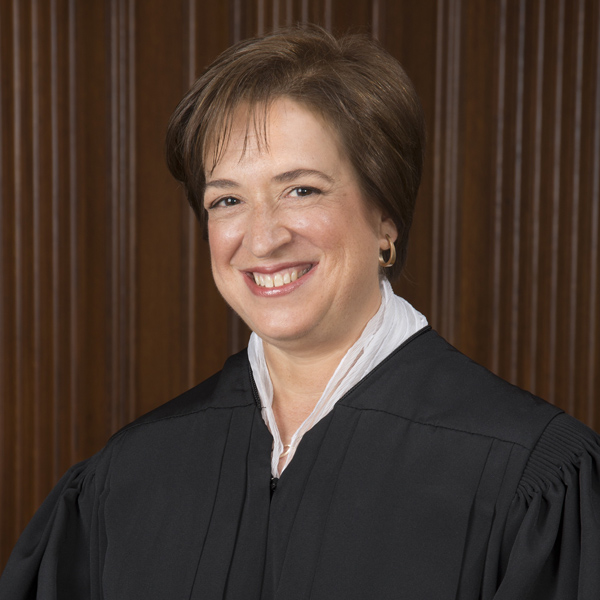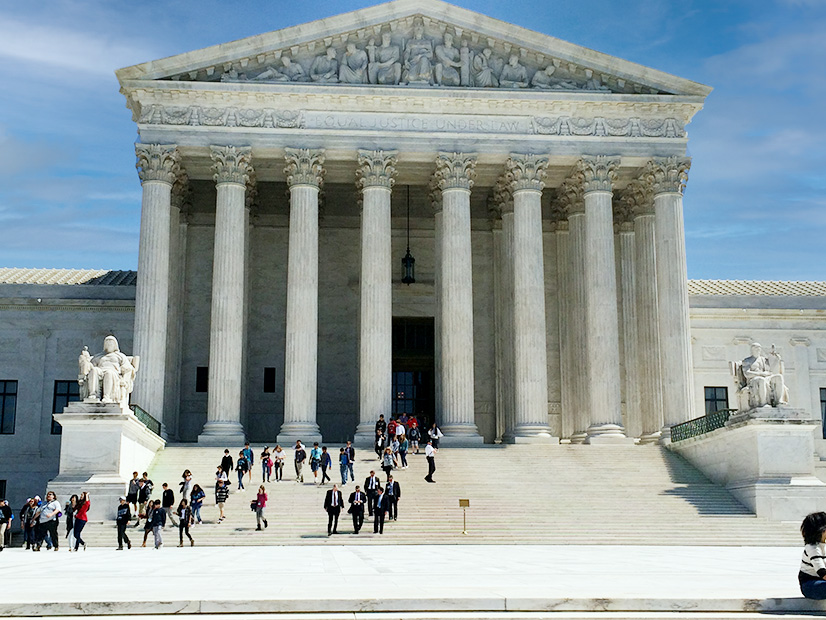The Supreme Court on Thursday ruled 6-3 that EPA lacks authority to compel generation shifting to reduce carbon emissions, saying the agency failed to provide “clear congressional authorization” for the rulemaking (West Virginia, et al. v. EPA, et al.).
The immediate impact of the court’s ruling is minimal: It voided the Obama-era Clean Power Plan, which was withdrawn by the Trump administration, and the Biden administration has said it would not attempt to implement it.
But as the latest in a series of orders by the conservative-dominated court to limit executive agencies’ discretion, it could act as a constraint on any future EPA action. The Biden administration told the court in oral arguments in February that it planned to issue a replacement for the CPP by the end of this year. (See Supreme Court Hears Arguments on EPA Authority over GHGs.)
President Biden called the ruling “another devastating decision that aims to take our country backwards.” He said he has directed officials to review the decision “and find ways that we can, under federal law, continue protecting Americans from … pollution that causes climate change.”
The CPP sought to cut power sector carbon emissions by 32% compared with 2005 levels by 2030 by substituting coal-fired generation with natural gas and renewables. EPA said it was permitted under Section 111(d) of the Clean Air Act, which empowers it to impose standards “for any existing source” based on limits “achievable through the application of the best system of emission reduction” (BSER) that has been “adequately demonstrated.”
 Chief Justice John Roberts authored the majority opinion, joined by Justices Thomas, Alito, Gorsuch, Kavanaugh and Barrett. | U.S. Supreme Court
Chief Justice John Roberts authored the majority opinion, joined by Justices Thomas, Alito, Gorsuch, Kavanaugh and Barrett. | U.S. Supreme CourtThe majority opinion, authored by Chief Justice John Roberts and joined by Justices Clarence Thomas, Samuel Alito, Neil Gorsuch, Brett Kavanaugh and Amy Coney Barrett, agreed with opponents who contended EPA’s authority to regulate power plants is limited to steps individual plants can make “inside the fence line.”
“At bottom, the Clean Power Plan essentially adopted a cap-and-trade scheme, or set of state cap-and-trade schemes, for carbon,” the court said. It reversed the D.C. Circuit Court of Appeals’ 2-1 ruling in 2021 that vacated the Affordable Clean Energy (ACE) rule, with which the Trump administration had proposed to replace the CPP. (See DC Circuit Rejects Trump ACE Rule.)
Roberts said the legality of the CPP was one of the “extraordinary cases” that require the court to weigh the “history and the breadth of the authority” claimed by an agency and the “economic and political significance” of its actions.
The court said the “major questions doctrine” was necessary to address “a particular and recurring problem: agencies asserting highly consequential power beyond what Congress could reasonably be understood to have granted.”
It cited previous rulings denying the Food and Drug Administration from claiming authority over tobacco products (FDA v. Brown & Williamson Tobacco, 2000); rejecting the Centers for Disease Control and Prevention’s authority to institute a nationwide eviction moratorium to prevent the spread of COVID-19 (Alabama Association of Realtors v. Department of Health and Human Services, 2021), and the Occupational Safety and Health Administration’s mandate requiring employees obtain a COVID vaccine or undergo weekly testing (National Federation of Independent Business v. OSHA, 2022).
Before the CPP, the court said, EPA had always set emissions limits under Section 111 “based on the application of measures that would reduce pollution by causing the regulated source to operate more cleanly.”
The Biden administration disputed that characterization, citing EPA’s 2005 Clean Air Mercury Rule, which it says relied on a cap-and-trade mechanism to reduce emissions. But Roberts said that rule set an emissions cap based on what was achievable by technologies that could be installed on power plants. “By contrast, and by design, there is no control a coal plant operator can deploy to attain the emissions limits established by the Clean Power Plan,” Roberts said.
EPA said it was operating within the law by limiting its regulations to those that will not be “exorbitantly costly” or “threaten the reliability of the grid.”
“But this argument does not so much limit the breadth of the government’s claimed authority as reveal it,” Roberts wrote. “On EPA’s view of Section 111(d), Congress implicitly tasked it, and it alone, with balancing the many vital considerations of national policy implicated in deciding how Americans will get their energy. EPA decides, for instance, how much of a switch from coal to natural gas is practically feasible by 2020, 2025 and 2030 before the grid collapses, and how high energy prices can go as a result before they become unreasonably ‘exorbitant.’ There is little reason to think Congress assigned such decisions to the agency.”
While Congress amended the National Ambient Air Quality Standards statute to explicitly authorize use of cap-and-trade as a compliance mechanism, it did not do so regarding carbon or Section 111, Roberts said.
“Generation shifting can be described as a ‘system’ … capable of reducing emissions,” Roberts acknowledged. “But of course almost anything could constitute such a ‘system’; shorn of all context, the word is an empty vessel. Such a vague statutory grant is not close to the sort of clear authorization required by our precedents.”
“When Congress seems slow to solve problems, it may be only natural that those in the executive branch might seek to take matters into their own hands,” Gorsuch wrote in a concurrence with Alito. “But the Constitution does not authorize agencies to use pen-and-phone regulations as substitutes for laws passed by the people’s representatives.”
Dissent
 Justice Elena Kagan wrote a dissenting opinion, joined by Justices Breyer and Sotomayor. | U.S. Supreme Court
Justice Elena Kagan wrote a dissenting opinion, joined by Justices Breyer and Sotomayor. | U.S. Supreme CourtThe majority’s ruling denies EPA “the power Congress gave it to respond to ‘the most pressing environmental challenge of our time,’” Justice Elena Kagan responded in a dissent, quoting from the court’s 2007 ruling that carbon dioxide and greenhouse gases are air pollutants under the Clean Air Act and can be regulated by EPA (Massachusetts v. EPA).
“The majority’s decision rests on one claim alone: that generation shifting is just too new and too big a deal for Congress to have authorized it in Section 111’s general terms. But that is wrong. A key reason Congress makes broad delegations like Section 111 is so an agency can respond, appropriately and commensurately, to new and big problems,” said Kagan, who was joined by Justices Stephen Breyer and Sonia Sotomayor in the dissent.
“Section 111 does not impose any constraints — technological or otherwise — on EPA’s authority to regulate stationary sources (except for those stated, like cost). In somehow (and to some extent) saying otherwise, the majority flouts the statutory text,” she wrote.
“The current court is textualist only when being so suits it. When that method would frustrate broader goals, special canons like the ‘major questions doctrine’ magically appear as get out-of-text-free cards,” Kagan continued. “Today, one of those broader goals makes itself clear: prevent agencies from doing important work, even though that is what Congress directed. That anti-administrative-state stance shows up in the majority opinion, and it suffuses the concurrence.”
Kagan said even facility-specific controls dictate “the national energy mix to one or another degree.”
“That result follows because regulations affect costs, and the electrical grid works by taking up energy from low-cost providers before high-cost ones. Consider an example: Suppose EPA requires coal-fired plants to use carbon-capture technology. That action increases those plants’ costs, and automatically (by virtue of the way the grid operates) reduces their share of the electricity market. … Everything EPA does is ‘generation shifting.’ The majority’s idea that EPA has no warrant to direct such a shift just indicates that courts sometimes do not really get regulation.”
Kagan also challenged the majority’s fear of the cost of the Obama plan, saying the CPP, “we now know, would have had little or no impact.”
During arguments before the court in February, the Biden administration said the electric industry achieved the CPP’s emission limits a decade ahead of schedule — without the regulation in place. Opponents countered that although the standards were largely met nationwide, 20 states had not met them.



